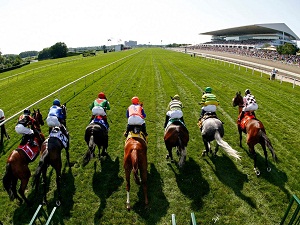
The excitement of the Preakness, the Kentucky Derby and the Belmont Stakes finishing are finished and Triple Crown hopes and dreams look towards next year’s signature races. Horses are vulnerable to injuries and so are the jockeys that ride them through training and high-stakes races.
Since 1940, more than 150 jockeys have died from racing accidents. Jockeys may have the most hazardous job of any professional athlete. One misstep in the crowded race can send a jockey, and perhaps his horse, tumbling to the ground, where he can be crushed by his own horse or another animal running behind.
There is no official database of jockey injuries and fatalities, but according to a study published in the Orthopedic Journal of Sports Medicine in 2013, a total of 152 jockeys died as a result of both flat and jump racing or training incidents in the U.S. between 1940 and 2012.
Take for example, Randy Meier, he was a leading jockey in the Chicago area who won more than 4,000 races before a traumatic brain injury forced him to retire. Over the course of his 38-year-career, Meier broke 56 bones in his body. He once broke both of his legs, he had a total of 10 broken vertebrates, he needed a rod surgically installed in his upper leg after breaking it, and he had screws and plates surgically installed in his neck when he broke it the first time.
The second time Meier broke his neck, at age 55, he also suffered a brain injury that left him unable to speak clearly. His short-term memory was affected, and he couldn’t remember his kids. He spent five and half months at a rehab center for speech therapy, all along thinking he would be back racing soon. Jockey’s Guild, which represents the majority of the roughly 900 riders racing today, is working on trying to improve safety on the racetrack to help minimize the injuries. Last year the organization started a database to document jockey injuries and conditions in which they occur, and it’s working to get racetracks across the country to report the injuries. The Guild eventually plans to use the database to spot trends and better understand what changes need to be made on the track as well as to the safety equipment jockeys wear, like vests and helmets.
Common jockey injuries include:
- Fractures – Legs, shoulders and arms are the most common among jockeys
- Dislocations
- Concussions
- Soft tissue injuries
- Serious head and spinal cord injuries
The position in which a jockey rides may also contribute to injury. Jockeys do not sit directly on the horse, but rather use their legs for gripping, stability, and balance. This forces them into a forward lean, creating a forced static posture over the horse. Jockeys are subject to dynamic and static joint loading, impact loading, and injuries associated with acceleration and deceleration from racing.
- The combination of the applied forces, static postures, repetitiveness, and trauma from joint loading may lead to musculoskeletal injury of the lower extremities and spine.
- Continual acceleration and deceleration from racing, while forced to maintain forward leaning postures, can propel a jockey over the head of the horse in the event of sudden stop or stumble by the horse, or result in contact with the horse’s head.
Contributing factors to any sports activity all have the potential for greater orthopedic injury. Orthopedic Specialists of Seattle specializes in sports medicine and treats a variety of sports-related injuries. If you are suffering from a sports-related injury, contact OSS to schedule an appointment with one of our physicians at (206) 633-8100.
